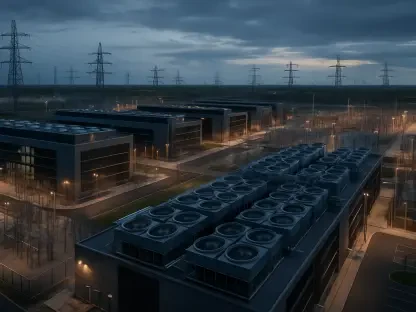Introduction
The staggering pace of artificial intelligence (AI) development has transformed industries, with companies leveraging AI for breakthroughs in drug discovery, fraud detection, and supply chain efficiency, often processing massive datasets in mere seconds. Yet, beneath this technological marvel lies a hidden challenge: the very networks that support these AI systems are struggling to keep up, creating bottlenecks that delay progress and inflate costs. This disparity between AI’s speed and network capabilities poses a critical barrier to innovation, affecting enterprises aiming to stay competitive in a fast-evolving landscape.
The purpose of this FAQ article is to address the pressing questions surrounding this disconnect, shedding light on why networks are falling behind and what can be done to bridge the gap. Readers can expect to explore the root causes of network limitations, the impact on AI deployment, and potential solutions for modernizing infrastructure. By delving into these topics, the goal is to provide clarity and actionable insights for businesses navigating the complexities of integrating AI with outdated systems.
This content aims to break down the technical and strategic challenges into digestible answers, ensuring that both IT professionals and business leaders can grasp the stakes involved. From understanding the specific demands AI places on networks to identifying paths toward scalable solutions, the following sections offer a comprehensive look at aligning infrastructure with the demands of cutting-edge technology.
Key Questions or Key Topics
Why Are Traditional Networks Unable to Support AI Workloads?
Traditional enterprise networks were designed decades ago for simpler data flows, primarily connecting branch offices to centralized data centers with predictable traffic patterns. These systems were never built to handle the immense data volumes, low-latency needs, and distributed architectures that AI workloads require, such as real-time processing across hybrid or multi-cloud environments. As a result, they create significant friction when organizations attempt to deploy AI solutions at scale.
The mismatch stems from AI’s unique characteristics, including the need to transfer massive, unstructured datasets for training models and the demand for high-performance computing resources often spread across multiple locations. When a network struggles to deliver the necessary bandwidth or speed, AI projects face delays, sometimes stretching from expected weeks to several months. This inefficiency not only slows innovation but also hampers the ability to capitalize on AI’s potential for quick decision-making and market responsiveness.
What Are the Consequences of Network Delays on AI Projects?
Network limitations directly translate into operational setbacks for enterprises eager to implement AI solutions. Projects that should launch swiftly are often stalled by the need to re-engineer infrastructure, such as redesigning wide-area networks or deploying new circuits, which can take months of manual effort. These delays disrupt timelines and frustrate data science teams who are ready to iterate on models but must wait for the underlying systems to catch up.
Beyond time, the financial toll is considerable as budgets swell with unforeseen costs tied to infrastructure overhauls and vendor coordination. Strategically, prolonged delays erode trust in leadership’s ability to deliver on AI promises and allow competitors with more agile systems to seize market opportunities. In an era where speed defines success, being held back by outdated networks can mean the difference between leading an industry or falling behind.
How Does the Pace of AI Innovation Contrast with Network Evolution?
AI technology evolves at a remarkable rate, with new model architectures, cloud services, and open-source tools emerging almost daily to push the boundaries of what’s possible. This rapid iteration enables businesses to continuously refine their capabilities, whether through smarter algorithms or more efficient data processing. However, the networks supporting these advancements remain anchored in legacy frameworks that prioritize stability over adaptability, creating a stark contrast in development speed.
Unlike AI, network infrastructure often relies on slow hardware refresh cycles and manual configuration processes that cannot match the dynamic needs of modern applications. This sluggishness means that even as AI tools become more accessible and powerful, the systems meant to enable them act as a persistent bottleneck. The irony lies in the fact that while AI is inherently fast-moving, the foundation it depends on remains mired in outdated designs and prolonged implementation timelines.
What Solutions Are Needed to Align Networks with AI Demands?
Addressing the network-AI disconnect requires a fundamental shift toward modern, cloud-first infrastructure that can scale dynamically with workload demands. Networks must integrate seamlessly with hybrid and multi-cloud environments, ensuring that data flows effortlessly across on-premises and external systems without compromising performance. Elasticity is key, allowing bandwidth and resources to adjust in real time to meet AI’s intensive requirements.
Moreover, performance metrics like low latency and high throughput must be prioritized without adding complexity for IT teams already stretched thin. Security should be embedded from the ground up, protecting sensitive data across diverse architectures and regulatory landscapes. Industry experts emphasize that incremental fixes are insufficient; instead, a complete rethinking of network design is necessary to prevent infrastructure from being the limiting factor in AI-driven transformation.
Summary or Recap
The discussion above highlights the critical gap between AI’s rapid advancements and the lagging capabilities of traditional network infrastructure. Key points include the inability of legacy systems to handle AI’s data-intensive and distributed needs, the resulting delays and costs that hinder project timelines, and the stark contrast in pace between AI innovation and network evolution. Additionally, the urgent need for cloud-first, scalable, and secure networks stands out as the path forward for enterprises aiming to fully harness AI’s potential.
These insights underscore the importance of viewing network modernization not as an optional upgrade but as a strategic imperative. Enterprises that overlook this foundation risk operational inefficiencies and long-term competitive disadvantages in an AI-driven market. For those seeking deeper understanding, exploring resources on cloud-native architectures and scalable networking solutions can provide valuable guidance on navigating this complex landscape.
Conclusion or Final Thoughts
Reflecting on the challenges discussed, it becomes evident that the journey of AI adoption is often thwarted by the very systems meant to support it, with outdated networks stalling progress at every turn. This realization pushes the narrative beyond mere identification of the problem and toward actionable strategies that could redefine how infrastructure aligns with technological innovation.
Enterprises are encouraged to prioritize investment in modern network solutions, focusing on elasticity and seamless cloud integration to break free from legacy constraints. By taking decisive steps to redesign their systems over the coming years, starting from 2025, businesses can position themselves to not only keep pace with AI advancements but also drive industry standards. This forward-looking approach invites consideration of how such changes might transform operational capabilities and competitive standing in an ever-accelerating digital era.









